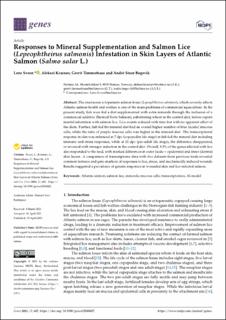Responses to Mineral Supplementation and Salmon Lice (Lepeophtheirus salmonis) Infestation in Skin Layers of Atlantic Salmon (Salmo salar L.)
Peer reviewed, Journal article
Published version
Permanent lenke
https://hdl.handle.net/11250/2740468Utgivelsesdato
2021Metadata
Vis full innførselSamlinger
- Artikler / Articles [1456]
- Publikasjoner fra CRIStin [2533]
Sammendrag
The crustacean ectoparasite salmon louse (Lepeophtheirus salmonis), which severely affects Atlantic salmon health and welfare is one of the main problems of commercial aquaculture. In the present study, fish were fed a diet supplemented with extra minerals through the inclusion of a commercial additive (Biofeed Forte Salmon), substituting wheat in the control diet, before experimental infestation with salmon lice. Lice counts reduced with time but with no apparent effect of the diets. Further, fish fed the mineral diet had an overall higher number of blue (acidic) mucous cells, while the ratio of purple mucous cells was higher in the mineral diet. The transcriptional response in skin was enhanced at 7 dpc (copepodite life stage) in fish fed the mineral diet including immune and stress responses, while at 21 dpc (pre-adult life stage), the difference disappeared, or reversed with stronger induction in the control diet. Overall, 9.3% of the genes affected with lice also responded to the feed, with marked differences in outer (scale + epidermis) and inner (dermis) skin layers. A comparison of transcriptome data with five datasets from previous trials revealed common features and gene markers of responses to lice, stress, and mechanically induced wounds. Results suggested a prevalence of generic responses in wounded skin and lice-infected salmon.
